
By Joh Marlß
Contents
Page
|
Introduction |
4 |
|
General activities |
6 |
Title Language
![]() the English alphabet
letter formation skills
the English alphabet
letter formation skills
![]() some basic vocabulary
getting used to writing in English
some basic vocabulary
getting used to writing in English
![]() O
Names the
verb to be 14
O
Names the
verb to be 14
![]()
O Colours colours 16
![]() Who is it? 18
Who is it? 18
O Numbers there is/there are 20
numbers I - 10 animal vocabulary plural s
![]() O Kites have
got 22 position of
adjectives
O Kites have
got 22 position of
adjectives
![]()
O A family family vocabulary 24 possessive 's
![]() can/can't
food
can/can't
food
Animal quiz question forms with do, have got and can 28
animal vocabulary  body parts
body parts
general vocabulary practice for a Starters format
![]() clothes vocabulary
present continuous
clothes vocabulary
present continuous
![]() imperatives classroom instructions
imperatives classroom instructions
![]() present there
is/there are practice for a Starters format
present there
is/there are practice for a Starters format
2
|
What's this? |
this practice for a Starters format |
40 |
|
Mirror writing |
phrases and expressions |
42 |
|
Crossword |
and/or, some, there is articles (a/an/the) do/does, have got |
44 |
|
Find the word |
spelling practice for a Starters format |
|
|
What are they doing? |
present continuous verbs |
48 |
|
Things in the house |
household objects |
50 |
|
Join the dots |
food and drink |
52 |
|
What are they saying? |
grammar revision |
54 |
|
Listen to the word |
pronunciation practice |
56 |
|
What's the word? |
vocabulary revision |
58 |
|
Monkey classroom |
vocabulary practice |
60 |
|
On the phone |
revision of questions and expressions |
62 |
|
What am l? |
practice for a Starters format |
64 |
|
Listening puzzle |
prepositions of place practice for a Starters format colours, animals |
66 |
|
Stairs |
vocabulary practice |
68 |
|
Mini-puzzles |
|
70 |
|
Teacher's notes |
|
70 |
|
Title |
Language |
|
|
a or an |
a/an |
72 |
|
Whose is it? |
possessive 's |
73 |
|
this, that, these, those |
this/that/these/those |
74 |
|
|
interrogatives: where/which/what/who/whose |
75 |
|
O Thanks, Mother! |
pronunciation of th |
76 |
|
Where's the bird? |
prepositions of place |
77 |
|
The word is . |
adverbs |
78 |
|
Grammar and vocabulary index |
|
79 |
Introduction
The puzzles in this book are for young learners between 7 to 10 years. They are easy to use, and have a number of aims:
Puzzles are fun. They are graphic, attractive and an enjoyable challenge to complete. Pupils enjoy being able to complete a puzzle in another language.
Pupils benefit from developing their own skills and strategies for learning.VVhen young learners are completing one of these puzzles, they are discovering their strengths and weaknesses in English. They are finding gaps in their knowledge, and developing and using skills to fill those gaps.
A whole lesson can be a very long time to expect young learners to focus their attention on the teacher - often their attention wanders and they start chatting in their mother tongue. The puzzles in this book allow pupils to work on their own, and aim to be absorbing and fun.As such, they help to keep the classroom atmosphere constructive, focused and conducive to learning.
![]()
The puzzles can be incorporated into a classroom lesson in a variety of ways:
I Choose a puzzle which is the right level for your class and which contains at least some language which will be new to them.
2 The Teacher's Notes facing each puzzle contain additional activities for both introducing and following up the puzzle. As a rough guide, using the puzzle plus all the activities in the accompanying Teacher's Notes will take 25 40 minutes.
3 If you wish to expand the lesson further, select one or more activities from the General Activities section following this Introduction.
These games and activities can be used to
4
practise a wide range of language, and so can be used for further practice of the language of the puzzle. They can also be used to extend the language of the puzzle. For example, if a puzzle contained twelve items of food vocabulary, you could use a general activity to revise those twelve items, and to introduce and practise a further six.
The puzzles mostly cover themes which are very common in coursebooks. Some have vocabulary aims (e.g. parts of the body) while others focus on grammar (e.g. the simple past). The puzzles and follow-up activities can be slotted into lessons with the same theme, preferably at the end, when learners are familiar with most, or all, of the language they will need for the puzzle.
The syllabus on which these puzzles are based (see page 5) may not match perfectly the syllabus of your course material: the Teacher's Notes to each puzzle contain suggestions for introducing/checking the necessary language before commencing the puzzle.
A popular way of organising young learners' lessons is to divide them into two parts. The first, which constitutes the bulk of the lesson, is specific in its language aim - perhaps a coursebook unit taught more or less as directed in the teacher's notes. This is followed with a more general, revision-based game or activity which students often interpret as being a 'reward' for having worked well in the first part of the lesson. These activities typically include quizzes, hangman, and other favourite games. Some of the puzzles in this book have general revision aims (and, of course, the required element of fun) and can be used in such an end-of-teggon slot. The Teacher's Notes for some of the puzzles contain ideas for using them as team games.
Teachers have differing opinions on whether or not it is a good idea to give young learners homework. For those in favour, many of these puzzles are suitable as homework assignments, especially if the introductory activities are used to set them up in class beforehand.
The puzzles in this book are based word-forword on the syllabus of the Cambridge Young Learners English Tests i.e. the vocabulary listed in the teacher's notes is the same as you would find in the Tests. Some of them use formats similar to those appearing in the Tests. The syllabus was derived from a survey of a wide variety of young learners course material from around the world, and is intended to be compatible with most young learners coursebooks.
The tests are at three levels: Starters (beginner), Movers (elementary) and Flyers (elementary/preintermediate), and the three books in this series correspond to those levels. (Information about the tests is available at www.cambridgeesol.org, or by post from Cambridge ESOL, I Hills Road, Cambridge, CBI 2EU, United Kingdom.)
However, the material in this book aims to be equally useful to classes which are not preparing for the Tests.
![]()
Preparation for all the puzzles is the same: make one photocopy per pupil. For a few of the puzzles, colouring pens or pencils are required. Procedure
The puzzles can be completed by groups of 2 to 4 working together, or individually with each learner likely to be collaborating on an unstructured basis with his/her neighbours.\Nhen the class is working in pairs or groups, give a copy of the puzzle to every pupil, otherwise all the work is likely to be done by the more able ones.
The teaching notes for each puzzle suggest how to introduce it. If further clarification is necessary, give a demonstration: perhaps copy a small part of the puzzle onto the board, and fill in the solution. Making sure everybody understands the format of the puzzle will be vital to its success as an activity. (To check that everybody has understood, perhaps ask a pupil to explain or demonstrate how the puzzle should be completed.)
Get the class to complete the puzzles in pencil so mistakes can be legibly corrected. If pencils are not available to all, you may like to make one or two extra copies in case anybody needs to start again. Additional games and activities
The teaching notes for each puzzle contain ideas for additional games and activities.These are 'optional extras' to be used if you think the class will benefit from them. They can also be used to expand the puzzles into full-length lessons (see above).
The General Activities following this Introduction can be used for further expansion, and as emergency 'fillers' if the lesson material is completed unexpectedly quickly.
Make a note of the problems you observe while the puzzle is being completed. Learners are likely to say the answers out loud as they find them.
Are there pronunciation problems? Do any of the grammar structures seem to cause difficulty? Was any of the vocabulary confusing?
When the puzzle has been completed go over any problem areas, perhaps using the following techniques:
![]() Practise pronunciation problems. Create tongue-twister fun by writing on
the board a series of words featuring the problem sound (e.g. this, that,
these, those, mother, father, brother). Get the whole class to shout it out in
unison, then ask individual pupils to try.
Practise pronunciation problems. Create tongue-twister fun by writing on
the board a series of words featuring the problem sound (e.g. this, that,
these, those, mother, father, brother). Get the whole class to shout it out in
unison, then ask individual pupils to try.
![]() Mime problem vocabulary. For example, mime sitting in an armchair (What
am I sitting on?), or sleeping (What am I doing?).The class shouts out the
answers.
Mime problem vocabulary. For example, mime sitting in an armchair (What
am I sitting on?), or sleeping (What am I doing?).The class shouts out the
answers.
![]() With grammar problems, use the information you collect to help plan
future lessons.
With grammar problems, use the information you collect to help plan
future lessons.
![]() If a class has serious difficulty completing the puzzle, give it to them
again at a later date. Their initial reaction may be 'We've done this!', but
explain that the aim this time is to do it 100% correctly.
If a class has serious difficulty completing the puzzle, give it to them
again at a later date. Their initial reaction may be 'We've done this!', but
explain that the aim this time is to do it 100% correctly.
The final seven puzzles in this book are quick, self-explanatory puzzles which pupils can do with little preparation and which will take less time to complete. They can be used for quickly practising the target language, as lesson-fillers or as additions to other puzzles. They are reproduced twice on each page in order to reduce photocopying.
|
General activities |
The following games can be used for further practice of the language featured in the puzzles. For suggestions on how to incorporate these activities into lessons, see the Introduction. (These activities can, of course, also be used in other lessons to practise language unrelated to the puzzles.)
![]()
Before the lesson, write down about 15 sentences which include words, phrases or grammar from the puzzle. To practice apple, for example, the sentence could be Do you like apples? To practice the present continuous, the sentence could be The monkey is eating a banana.
I Organise the class into two teams. Each team stands in a line.
2 Stand at the back of the lines.Ask the pupils at the back of each line to come to you.
3 Whisper a sentence to them. They return to the back of their respective teams and whisper the sentence to the pupil in front of them. This pupil then whispers to the pupil next to them and so on.
4 Meanwhile, the teacher walks to the front of the lines.
5 As soon as the sentence reaches the front of a line, the pupil at the front puts up his/her hand. Wait until both teams have finished. Ask the pupil who put up their hand first to say the sentence: if it is identical to the one the game started with, that team gets a point. If the sentence is not the same, ask the pupil at the front of the other team. If their sentence is correct, award them a point instead.
Tips
If anybody whispers loudly enough for more than one person to hear, give the other team a point.
Keep the score on the board, using team names such as Cats and Dogs.
If there is an odd number of pupils, add another stage: whisper the sentence to pupil A then he/she whispers it to pupils B and C; they run to their respective teams and continue the process.
00000000
Teacher A
c QB 00000000
After a few rounds, get pupils to change their positions in the lines.
This version of a favourite ELT game can be used to practice vocabulary with young learners.
Make a list of vocabulary. This should include most of the words from the puzzle, plus plenty of other words which the class has learned. Make sure it is possible to mime all the words.
I Put a chair in front of the board. Organise the class into two or three teams.
2 Get a member of Team A to come and sit on the chair. He/she must not look round at the board. Write three words on the board.
3 The other members of Team A must mime the first word.\Nhen the pupil in front of the board guesses it (or gives up), they move on to the next word, and so on. The turn lasts for one minute.
4 Award Team A one point for each word correctly guessed. Then it is Team B's turn, and so on.
![]() Keep the score on
the board, using team names such as Apples and Bananas.
Keep the score on
the board, using team names such as Apples and Bananas.
![]() Make sure your
choice of vocabulary is fair - if one team feels their words are more
difficult, they may complain vigorously.
Make sure your
choice of vocabulary is fair - if one team feels their words are more
difficult, they may complain vigorously.
![]()

Continue playing until
everybody has had at least one turn at the board.
![]() Let everybody mime, instead of just
the team mates of the pupil at the board.
Let everybody mime, instead of just
the team mates of the pupil at the board.
e In the adult version of the game, teams define the words on the board, rather than miming them. This may work for older, higher level groups of young learners.
A popular game which can be used to practise parts of the body and other vocabulary.
![]() Get the class to stand up. Introduce
the word touch. Practise a few commands such as Touch your
arm, Touch your ear.
Get the class to stand up. Introduce
the word touch. Practise a few commands such as Touch your
arm, Touch your ear.
2 Then explain they must do the command only if it is preceded by the words Simon says.
3 Give further commands, some with and some without Simon says. Anybody who accidentally follows a command not preceded by Simon says is out. The last player remaining in the game is the winner.
With higher level groups, use commands based on miming target vocabulary: drive a car, eat a Pizza, be a monkey, read a book, etc.
7
|
4 Disappearing elephant |
This is an adaptation for young learners of the ever-popular game 'Hangman'.
Make a list of vocabulary. This should include most of the words from the puzzle, plus plenty of other words which the class has learned.
I Draw a picture of an elephant on the board like this:

2 Choose a word from your list.VVrite a line for each letter on the board. Ask pupil A to guess a letter. If the letter is in the word, write it in the appropriate space. If the letter is not in the word, write it elsewhere on the board, and rub out one part of the elephant (begin with the trunk, then the eye, then the mouth, then the ear, then the head, etc.)
3 Next it is pupil B's turn and so on. Anybody can put up their hand at anytime and guess the word (but shouting out is not allowed).
![]()
 e s m t PO
e s m t PO4 If nobody has guessed the word when all the parts of the elephant have disappeared, reveal the word and start again with another word. If a pupil guesses the word correctly, he/she has won that round.
Instead of a word, the game can be used to practise sentences. These should be fixed phrases such as What time is it? On the board, write the first word, and spaces for the remaining words.
The game then proceeds as described above, but with the class suggesting words rather than letters.
![]()
A student-centred version of bingo.
![]() Get the class to brainstorm
vocabulary from the topic featured in the puzzle (e.g. 'Things you can eat').
Write the words on the board.
Get the class to brainstorm
vocabulary from the topic featured in the puzzle (e.g. 'Things you can eat').
Write the words on the board.
2 Then draw this grid on the board for pupils to copy.
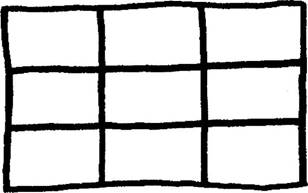
3 Each pupil chooses nine of the words to write into his/her grid.
4 Pupil A chooses a word from her/his grid and calls it out. He/she can cross out the word, as can other pupils who have the word in their grids. Then it is pupil B's turn to call out a word, and so on.
5 The first pupil to cross out all his/her words is the winner.
An activity which can be used to practise any language.
On a piece of paper write ten or so sentences featuring the target language (e.g. sentences in che present continuous).
I Divide the class into two teams. If necessary, move the tables to the walls. The teams stand at one end of the classroom (not too close together). At the other end there is the sheet of paper containing the sentences,
|
|
|
|
Paper
|
Tea M A Team B
|
2 A member of each team walks as fast a possible to the paper, memorises a sentence, returns to his/her team, and dictates the
sentence. For safety reasons, they are not allowed to run!
![]() 3 Then another team member has a turn, and so on.
Monitor, and disallow any incorrect sentences (the team member must go back and
try again).
3 Then another team member has a turn, and so on.
Monitor, and disallow any incorrect sentences (the team member must go back and
try again).![]()
4 The first team to collect a full
set of sentences wins.![]()
This game can be used to practise word order.
I Divide the class into two or more teams.
2
Select some
sentences containing the target language (e.g. questions beginning with do and
does). Concealing what you are doing with a piece of paper, write the first
sentence on the board with the words in the wrong order: ![]() you ice-cream like do?
you ice-cream like do?
3 Reveal the words. The first team to say the sentence in the correct order wins a point.
Continue with further sentences.![]()
![]()
This is the same as game number 7 above, but instead of guessing jumbled sentences, teams try to solve anagrams of individual words.
Organise the class into groups of three or four.
2 Write examples of the target language
on the board. This could be about 1 5 words from a vocabulary group (e.g.
things to eat and drink) or about 8 short sentences (e.g. short questions
beginning with What).![]()
3 Give the pupils about a minute to memorise the language, then wipe the board clean.
4 Each team must write down as many of
the items as they can remember. The team that remembers the most items wins.![]()
![]()
I After a puzzle has been completed, get the class to put their copies of the puzzle away.
![]() 2 Dictate about ten words from the puzzle. The pupil who spells the
highest number of words correctly is the winner.
2 Dictate about ten words from the puzzle. The pupil who spells the
highest number of words correctly is the winner.
 The alphabet
The alphabet
the alphabet letter formation skills
I Write some words or names familiar to the class on the board. Point to a letter, say the letter, then get the class to repeat it. Continue with further letters. (The sounds of the alphabet are a good introduction to the sounds in English words.)
2 Write the whole alphabet on the board. Underline letters a to f. Say the a very quietly, the b a little more loudly, and so on, ending with a really loud f. Get the class to repeat. Continue with letters g to l, this time starting loudly and getting quieter. Then go from m to r starting with a low voice and getting higher. Finally go from s to z starting slowly and getting quicker.
3 Hand out copies of the puzzle. Pupils work individually to find the shapes of letters and connect up the dots.
![]()
Collect together a large quantity of paper clips, counters, jigsaw pieces or any other suitable objects. Set a time limit of 30 seconds. Pupils use the objects to form names or English words which are familiar to them.\Nhoever makes the most words in the time wins. Repeat as required.
Clear a space in the classroom. Organise the class into two or
more teams (there must be at least 10 in each team). Say a letter. The members
of each team must organise themselves so that they are standing in the shape of
that letter. The first team to do this wins a point.![]()
Everybody stands up. Say a letter. Everybody must make their body into a shape which looks like that letter.

 Alternative method letters wins.
Alternative method letters wins.
 |
basic vocabulary items writing in English
• cat, banana, dog, computer, apple, pen, robot, house, pencil, jeans, elephant, ball
I Give out copies of the puzzle.
2 Pre-teach/check the vocabulary in the puzzle: hold up a copy, point to one of the items, and ask, What's this? (It's a dog.) Do the same with the other items, and repeat until everybody seems confident saying the words. 3 Pupils do the puzzle.
4 Write the answers on the board, or get a succession of pupils to do it. If practical, look at everybody's worksheet to check their answers. Key
 cat banana
dog computer apple pen robot horse pencil jeans elephant ball
cat banana
dog computer apple pen robot horse pencil jeans elephant ball
![]()
![]() activities
activities
Divide the class into two or more teams. Select a word from the coursebook you use.XNrite it on the board using the same method of jumbling as the puzzle. The first team to guess the word correctly wins a point. Continue with further words.
Working in pairs or individually, the class make their own worksheets using the same format as the puzzle. The class could choose words from their coursebooks, or from words you have written on the board. (Perhaps limit the number of words in each puzzle to six or seven.) When they have finished, they exchange with other pupils/pairs and complete each other's puzzles.
Each pupil chooses six of the items on the puzzle, and puts a circle around each of them. Call out the items at random: if a pupil has circled the object you call, he/she can cross it off. The first pupil to cross off all six chosen items is the winner.

![]()
![]()
![]()
![]()
![]()
![]()
![]() o oo douo!—
o oo douo!— 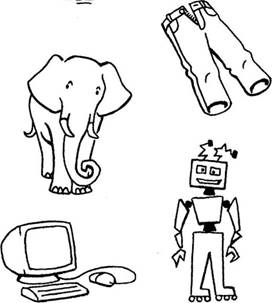
@
13
|
|
|
to be
Structures
I am, he/she is, they are, we are, Who are you?

 Draw seven
simple faces on the board, and write the following names under them: Tom, Nick,
Sam, Sue, Ann, Bill, Ben. Point to the faces and to people in the room, and
make statements such as He is Bill, They ore Nick and Ann, I orn Ben, We ore
Ann and Sue. Some of the statements should be true and some false. After each
statement, the class must shout out yes or no accordingly.
Draw seven
simple faces on the board, and write the following names under them: Tom, Nick,
Sam, Sue, Ann, Bill, Ben. Point to the faces and to people in the room, and
make statements such as He is Bill, They ore Nick and Ann, I orn Ben, We ore
Ann and Sue. Some of the statements should be true and some false. After each
statement, the class must shout out yes or no accordingly.
2 Give ouc copies of the puzzle for pupils to complete. They first draw matching lines between the speech bubbles and the characters they describe (using the t-shirts on the clothes line to help them identify the characters). Then they complete the phrases below.
They are Bill and Ben. He is Nick.
They are Sam and Sue.
He is Tom.
She is Ann.
![]()
For each pupil you will need a piece of paper and a piece of
scicky tape. Write the name of one member of class on each piece of paper.
Stick one of these name tags on the back of each pupil, making sure that
everybody has somebody else's name, Pupils then circulate, asking each other Am
![]() and
getting the answer yes or no. Once a pupil gets a yes answer, he/she sits down,
This continues until everybody is seated.
and
getting the answer yes or no. Once a pupil gets a yes answer, he/she sits down,
This continues until everybody is seated.

colours
black, blue, brown, green, grey, orange, Pink, purple,
![]() red, white, yellow
red, white, yellow

![]()

![]() I Each pupil
will need colouring pens/pencils. Introduce/check colours by pointing to things
in the room, and asking the class to shout out their colours.
I Each pupil
will need colouring pens/pencils. Introduce/check colours by pointing to things
in the room, and asking the class to shout out their colours.
2 Hand out copies of the puzzle. Students colour the picture as directed When it is coloured it will reveal a bowl of fruit. (You could also use this to practise fruit vocabulary.)
Organise the class into pairs, and hand out copies of the puzzle. The first pair to correctly identify the hidden picture wins.
![]()
(This activity is not suitable for classes wearing uniform.) Each pupil chooses five colours, and writes them down. Call out the name of a person in the class, for example, Maria. Students can cross off all the colours in their list that Maria is wearing. Then call out the name of another pupil, and so on. The first pupil to cross off all five of their colours is the winner. Repeat as required.
2 Yes or No?
Use colours to revise previously-taught vocabulary: call out sentences such as Bananas are yellow ( the class says Yes!), Elephants ore blue. (No!) and Cors are orange. (Yes! - it's possible).
Colours O

What can you see?
 Who
Whosimple present tense sentences with adjectives
adjectives: small, young, happy, old, big, sad nouns: boy, girl simple present: he is/she is, Who...?
I Introduce/check the vocabulary, e.g.
make a ![]() sad face, then ask, Am I happy or sad?
Point to a pupil, Is she a boy or a girl?. Repeat with
sad face, then ask, Am I happy or sad?
Point to a pupil, Is she a boy or a girl?. Repeat with
further people/objeccs to introduce/check boy/girl, happy/sod, big/small, old/young.
2 Hand out copies of the puzzle. Read part I out loud, and elicit an answer.
3
![]()
![]()
![]() The class
then does the other three parts independently.
The class
then does the other three parts independently.![]()
2 Torn
4 Sam
![]()
Divide the class into two teams. Ask the following questions about the characters in the worksheet. (the first team to answer each question wins a point).
![]() He's big. He's old-Who is it? (ANSWER:
It's
He's big. He's old-Who is it? (ANSWER:
It's
2 He's 1 0. He's happy, (Bill) 3 He's young. He's small. He's sad. (Nick)
4 He's big. He's ' O. (Sam)
5 She's big. (May)
6
She's 10. (Kim)![]()
7 She's small and happy. (Ann)![]()
8 He's small and old. (Torn)
9
![]() He's big and happy. (Ben)
He's big and happy. (Ben)
10 He's young, small and happy. (Bill)
Who is it?
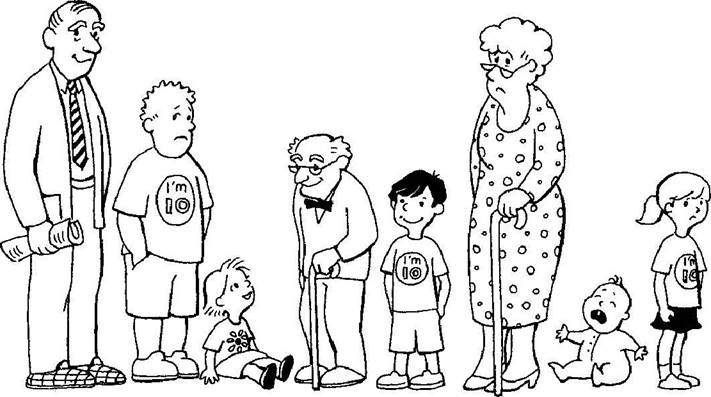
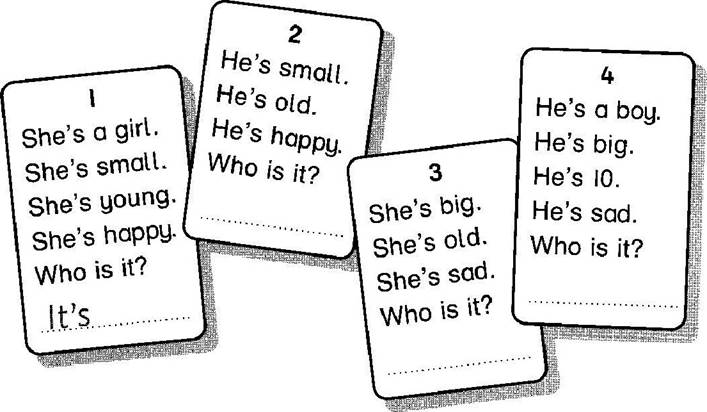
DELTA PUBLISHING 1003
 Numbers
Numbersthere isltbere are numbers I - 10
animal vocabulary plural s
crocodile, cat, spider, elephant, dog snake, giraffe, monkey, birds, tiger
Get the class to count from one to ten.
Repeat until everybody seems confident.
Z Write the numbers (in letters) in random order on the board, and get the dass to repeat them,
3 Hand out copies of the puzzle for completion, If any of the animal vocabulary is new, answer queries by pointing at the pictures.
4
As pupils get near the end, point out that question 10 is
different to the others (there is ![]() rather than there are).
rather than there are).
This method also practises colours and pupils will need colouring pens/pencils. Give the fol!owing instructions:
Colour the cats orange.
Colour the giraffes yellow. ![]() Colour the dogs brown
Colour the dogs brown
Colour the elephants grey.
Colour the crocodiles green. Colour
the snakes purple.![]()
Colour the monkeys PinkColour the birds blue,
COIOUr the tiger red
Pupils then complete the puzzle.
3 seven
4
four![]()
7 two
9
ten![]()
10 one
![]()
I One potato, two potato ![]() Teach che class the
following British
Teach che class the
following British ![]() schoolchildren's action rhyme:
schoolchildren's action rhyme:
One potato, two Potato, three potato, four.
Five POtoto, six potato, seven potato, more, Q U, T, spells 'out', so out you must go.
This is accompanied by an action: groups Of up to six put out
their right fists, one on top of each other to make a tower. With each word in
bold in the rhyme, the person whose fist is at the bottom removes their fist
and places it on top of the ![]() tower.At the end of the rhyme, the person
whose fist is at the top of the pile is out. The remaining players repeat the
rhyme until only one person is left - the winner,
tower.At the end of the rhyme, the person
whose fist is at the top of the pile is out. The remaining players repeat the
rhyme until only one person is left - the winner,
Pupils take it in turns to mime an animal. while ![]() the rest of
the class guess and shout out the name (e.g. It's a monkey.).
the rest of
the class guess and shout out the name (e.g. It's a monkey.).

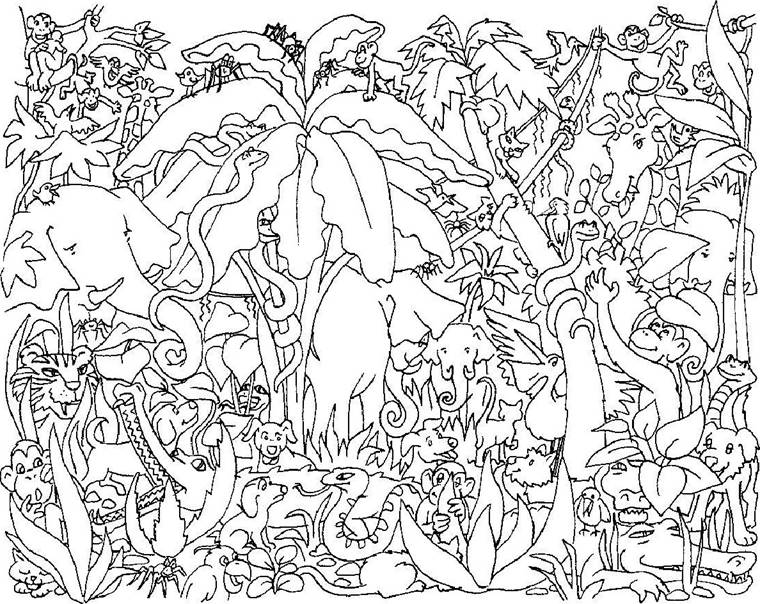
hove got position of adjectives![]()
adjectives: big, smolt, black, white, dirty, clean, old, new
• nouns: girl, boy, dog, robot, monkey, bird, snake, cot, monster hove got
Introduce/ch eck the adj ectives, perhaps by pointing to things in the classroom and asking is it big or small?, What colour is it? etc. Elicit answers from the pupils.
2 Hand out the puzzles to the class. Pupils complete by following the jumbled lines and copying the descriptions into the correct sentence.
 Divide the class into two teams, and
hand out copies of the puzzle. Ask Who's got the old grey kite? The first
person to put up their hand and give the correct answer wins a point for their
team. If members of both teams put up their hands at the same time, give each a
point, Keep the score on the board. Continue with the other kites.
Divide the class into two teams, and
hand out copies of the puzzle. Ask Who's got the old grey kite? The first
person to put up their hand and give the correct answer wins a point for their
team. If members of both teams put up their hands at the same time, give each a
point, Keep the score on the board. Continue with the other kites.![]()
2 small black
3
old grey 4![]()
5 dirty white
6
new grey![]()
7 clean white
8 very big
9 big black
![]()
I What is it?
Use the vocabulary from the worksheet to describe an item in the classroom (e.g. for a wastepaper basket: it's small, green, old and dirty. Wbot is it?).The class must find and point to the item (it doesn't matter if they don't know the word in English). Repeat as required.
![]()
2 Yes or no?
Make statements like the ones below. The class must shout out Yes or No accordingly.
Elephants ore big.
Giraffes are small.![]()
Elephants ore grey.
Crocodiles are black and white.
Cots are very big.
Tiger5 are black and orange.
Giraffes are green and red.![]()
I am old.

![]()
5 The monkey
![]()
6 The bird
![]()
![]()
![]()
9 The monster
![]()
![]()
DELTA PUBLISHING 2003 23
 A family
A family![]()
family
vocabulary ![]() Our
family trees
Our
family trees
|
e possessive s |
Get the class to draw their own simple
family |
|
e hove got |
trees, using the vocabulary from the puzzle. For |
|
position of adjectives. |
each
relative, they must write the name, and the |

![]() relationship
to themselves. For examp\e:
relationship
to themselves. For examp\e:
e sister, brother, father, mother, ![]() grandfather, children, short, long,
black, white
grandfather, children, short, long,
black, white
 Mork
Mork ![]() my
grandfather
my
grandfather
2 Who's in the family?
Introduce the additional vocabulary items son and daughter.
Organise the class into groups of six to eight, preferably with boys and girls
mixed more ![]()
![]() or less evenly. Each group will become a
family,
or less evenly. Each group will become a
family,
Procedure and must secretly decide on a family role for each
I The concept of a family tree
may be unfamiliar member. For example, a group might decide to to the class.
Demonstrate by drawing part of![]() become three grandparents, a mother and
two your own family tree on the board: This is me,
become three grandparents, a mother and
two your own family tree on the board: This is me,![]() children. (If
available, dressing up materials could this is my brother Mario, etc, Use the
family be used.) words featured in the puzzle. Group A goes for a walk round the
classroom in
children. (If
available, dressing up materials could this is my brother Mario, etc, Use the
family be used.) words featured in the puzzle. Group A goes for a walk round the
classroom in ![]() 2 Hand out copies of the puzzle for the
class to
2 Hand out copies of the puzzle for the
class to![]() the characters of their chosen family
members.
the characters of their chosen family
members.![]()
|
complete by writing yes or no-
Key 9 no |
Everybody else must try to guess which family role each person is playing (Are you a daughter/sister?) When a pupil's role has been correctly guessed, they sit down. When all the |
![]() roles have
been guessed, it is group B's turn, and
roles have
been guessed, it is group B's turn, and
2
no so on.![]()
3 no
5 no
8 no

Nick Sue

Ann Ben Sam
yes or no?
|
2 Ann has got three brothers. 3 Ben's father has got long hair. 4 Nick and Sue hove got three children. 5 Sam's grandmother has got black hair. 6 Sue's mother is Ben's grandmother. 7 Ann's grandfather is Nick's brother. 8 Ben's grandfather is young. 9 Sam's sister has got short hair. 10 Tom and Pat have got one child. Il Sue's father is Ann's grandmother. 12 Ann's brothers have got black hair. 13 Ann's mother's mother has got white hair. 14 Sam's brother's father has got long hair. 15 Ann's brother's mother's children are young. |
ges
|
|
© DELTA PUBLISHING 2003 |
25 |
 Can the monkey have the banana?
Can the monkey have the banana?
![]()
|
• canlcan't |
What can you feel? |
|
• food and animal vocabulary |
You will need a selection of objects concealed in a bag. Pre-teach (by miming) the word feel. |
Nominate a pupil to close his or her eyes, Give
Vocabulary him/her an object,
The pupil must guess what it is, have, monkey, cat, horse, dog, Pizza, fish,
orange and say I can feel a (They can use mother ![]() juice, apple,
ice-cream, meat, cake tongue for the object if necessary.)
juice, apple,
ice-cream, meat, cake tongue for the object if necessary.)

I Put an unusual object (for example,
a red bag) ![]() somewhere in the classroom where some
pupils can see ic and some can't, Ask various members of the class Con you see
the red bog?
somewhere in the classroom where some
pupils can see ic and some can't, Ask various members of the class Con you see
the red bog?
2 If the class is not familiar with the
concept of a maze, hold up a copy of the puzzle, and trace the monkey's route
towards the banana. Can he have it or not? (Yes, he can). Write can in the
space in sentence I a.t the bottom of the ![]() puzzle. (If you have
access to an OHP, chis could be done on the screen,)
puzzle. (If you have
access to an OHP, chis could be done on the screen,)![]()
![]() 3 Give out copies of the puzzle for pupils
to complete.
3 Give out copies of the puzzle for pupils
to complete.
2 can't 3 can
4 can
5 can't 6 can't
![]()
7 can't
8 can

 Animal quiz
Animal quiz
Language aims
![]() animal vocabulary
animal vocabulary ![]() simple
present tense
simple
present tense ![]() con
con ![]() hove got
hove got![]()
• giraffe, tiger, frog, dog, bird, crocodile, monkey, duck, cow, horse, snake, lizard, goat, spider, mouse/mice, hippo, sheep, elephant, chicken, cat

Organise the class into two or more teams. Reading from the puzzle, ask team A a question. If they are correct, they win a point.
Then ask team B a question, and so on. Translate any words the class don't know, or draw sketches on the board.
2
3
All the animals are illustrated on the puzzle. If any animal
vocabulary is unfamiliar to the class, hold up a copy and point to the relevant
![]() illustration.
illustration.
2 No
5 No 15 No (they've got eight)
10 Yes 20
No (not properly)![]()
![]()
Get a pupil to come to the front of the class. Secretly point to one of the animal illustrations on the puzzle. The pupil must then silently mime that animal, while the rest of the class try co guess which one it is. Continue until everybody has had at least one turn at miming.
Each pupil draws six different animals. Pupil A calls out one of his/her animals, and he/she and anybody else who has that animal crosses it off. Then student B calls out one of his/her animals and so on. The first person to cross out all their anima's is the winner. Repeat as required.
![]()
 |
 Parts of the body
Parts of the body• parts of the body
e head, hair, face, nose, eye, ear, arm, hand, foot, feet, leg, body

Practise the vocabulary by pointing to your own head, nose, foot, etc, and getting the class to call out the words. Repeat until everybody seems confident. Write any unfamiliar words on the board, and leave them there.
2 If the class are not used to anagrams. write one or two from the puzzle on the board, and elicit answers.
3 ![]() Give
out copies of the puzzle. Pupils unscramble the body anagrams next to the
monster, and then use these words to label parts of the robot.
Give
out copies of the puzzle. Pupils unscramble the body anagrams next to the
monster, and then use these words to label parts of the robot.
face head nose ![]() ear
ear ![]() body arm
leg hand
body arm
leg hand
foot
|
3 hand |
9
nose 10 foot |
|
4 body 5 head
7 arm |
12 ear 14 ear |
|
8 mouth |
16 hand |
![]()
![]() Ask the class to stand up. They must follow your
instructions, but only when preceded by the phrase Simon says.... Anybody who
accidentally
Ask the class to stand up. They must follow your
instructions, but only when preceded by the phrase Simon says.... Anybody who
accidentally ![]() starts to follow an instruction not
preceded by Simon says... is out, and must sit down. Give instructions such as
(Simon says) move your leg and (Simon says) put your hand on your ear. To begin
with, demonstrate the instruction as you give it. Later on, just give verbal
instructions. The last person still standing is the winner.
starts to follow an instruction not
preceded by Simon says... is out, and must sit down. Give instructions such as
(Simon says) move your leg and (Simon says) put your hand on your ear. To begin
with, demonstrate the instruction as you give it. Later on, just give verbal
instructions. The last person still standing is the winner.
Describe a monster for che class to draw. For example, The
monster has got very big ears. He's got ![]() three short legs and
big feet Repeat the activity
three short legs and
big feet Repeat the activity
![]()
with pupils taking it in turns to give the instructions.

![]() Help the professor make his robot.
Help the professor make his robot.

3 1
 Can you see it?
Can you see it?
Language aims
|
Vocabulary |
• practice
for a Starters format ![]() spelling
spelling ![]() vocabulary
vocabulary
•
![]()
![]()
television, pencil, armchair,
bed, helicopter, boat, lamp, guitar, watch, book, ruler, computer, ice. cream,
sofa
L Hand out copies of the puzzle. Check that everybody understands what they should be doing: they identify the objects and unscramble the words to write the names. Tell the class to do the ones they can, and to leave the others.
2 Go through the answers with the class together, and write the answers on the board.
![]() table
table
|
pencil |
10 guitar |
|
3 television |
I I computer |
|
4 armchair |
12 watch 13 book |
|
6 boat |
14 ice-cream |
2
7 helicopter
Organise the class into teams of up to 4, and hand out copies of the puzzle. The team that gets the most answers within a given time (e.g. 10 minutes) wins.
![]()

spider, nose, shoe, snake, trousers, elephant, burger, door
Organise the class into pairs/small groups. Give each a photocopy of the pictures above, or project it using an OHP.The pairs/groups must try to identify the objects, and write down the words. The pair/group with the most correct (or plausible alternative) answers wins.
8 lamp

 are
are
Language aim
• clothes vocabulary
|
|
|
• hat, jacket, jeans, handbag, dress, glosses, trousers,
T-shirt, shirt, shoes, socks, skirt
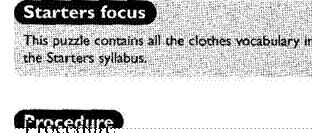
I Hand out copies of the puzzle.
2 Hold up a copy, and point to each of the aliens in turn. What is she (or he) wearing? Repeat until everybody seems confident with the vocabulary and the pronunciation.
3 Write on the board the words with the more difficult spellings, plus any words which the class didn't know, and leave them there.
4 Pupils complete the puzzle.
wearing?
Describe a pupil's clothes without mentioning COIOUrS, e.g. She's weanng jeans, o big pullover and an old jacket The class must guess who you are describing. Repeat as required. (This activity will not work if the class is in uniform.)
If a dressing-up box is available, bring it to the lesson. Arrange the clothes so that they are visible. The students take it in turn to ask for a garment by describing it, e.g. The green hat The class can then wear their chosen garments for the rest of the lesson.
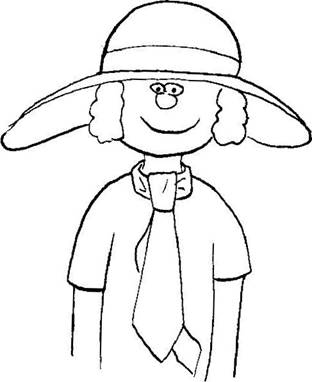
|
Across: |
Down: |
|
|
2 jacket |
|
hat |
|
3 handbag |
2 |
jeans |
|
5 glasses |
4 |
dress |
|
6 trousers |
6 |
T-shirt |
|
8 shoes |
7 |
shirt |
|
I O skirt |
9 |
socks |
are wearing?
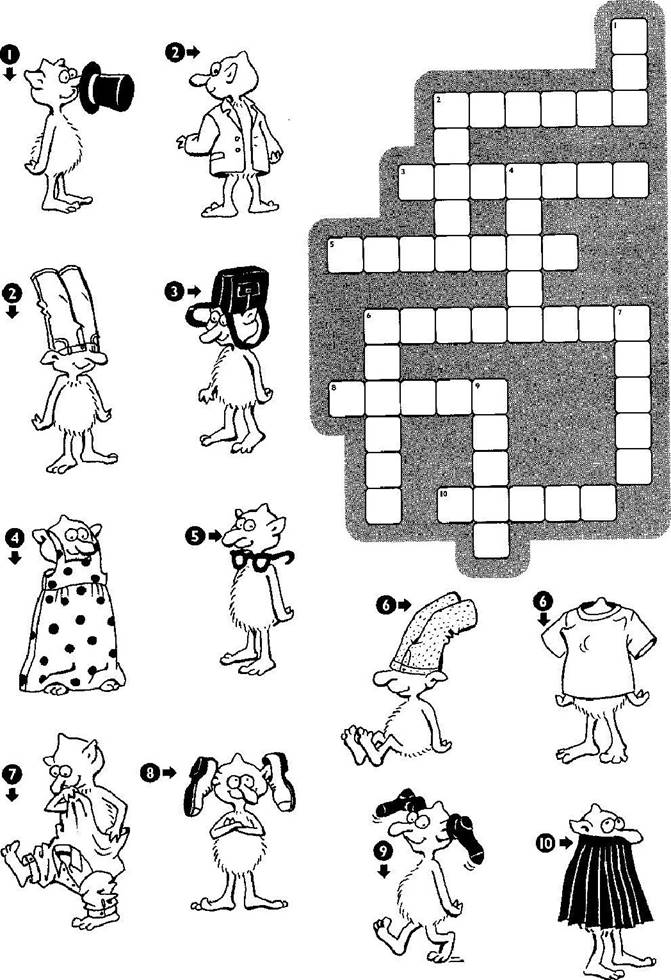
 do teachers want?
do teachers want?
|
• classroom instructions |
Taking it in turns, pupiis mime an instruction from che puzzle, and the rest of the class calls it out. |
![]()
![]() I Give out copies of the puzzle, but
tell the class not to write anything yet.
I Give out copies of the puzzle, but
tell the class not to write anything yet.
2 Mime one of the instructions from the puzzle. The class has to find the instruction in the list, and call it out. Repeat with the rest of the instructions.
3 Pupils now complete the puzzle by writing the sentences in the appropriate speech bubbles.
Key 2 Open the window, 3 Clean the board. 4 Sit down, please, 5 Be quiet, please.
6 Close your books.
7 Listen to this.
8 Colour this.
9 Draw this.
10
Say that again![]()
What do the teachers want?
![]() Sit down,
please.
Sit down,
please.
Listen to this.
Say that again.
Colour this.
Clean the board.


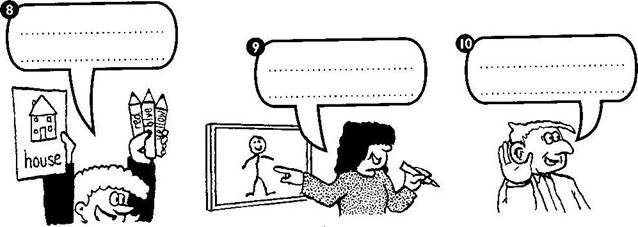
37
O 2003
 and now
and now![]()
![]() colours
colours ![]() classroom vocabulary
classroom vocabulary ![]() there is/there ore
there is/there ore ![]() present
continuous
present
continuous
block, blue, brown, white, shoes, glasses, T-shirt, socks, girl, boy, board, classroom, desk, ptcture, wall, bag, floor, clock, book, pen, chair, window, door

l. Give out copies of the puzzle. Show how to do it by answering the first three or four questions out loud for yourself, e.g. I am wearing black shoes. No, my shoes are brown. I write 'No' here.
2. Each pupil then completes the puzzle, answering for himself/herself.
|
Additional activities |
I All about a pupil
Pick a pupil who isn't shy. Divide the rest of the class into teams of 2 co 4. In turn, each team makes a statement about the pupil, e.g. She's got black hair. They can use the puzzle for inspiration. When a team can't think of a new sentence they are •out'. The last team left in the game wins.
2 Make your own sentences
Pupils write another five 'Here and now' sentences about themselves. They then read these sentences to a partner who has to answer them with yes or no for himself/herseff.
3 Yes or no
Each pupil must write yes and no on a page of their notebooks like this:
|
|
|
ses no |
|
|
Everybody shuts their eyes. Make a yes/no a statement about the room, e.g. the clock is grey, Antonio is wearing a blue T-shirt). Pupils, keeping their eyes closed, must point to yes or no on their sheets accordingly. Then they can open their eyes. Everybody who was right can award themselves a point.At the end of the game, the person with the most points is the winner.
 What's this?
What's this?
• practice for a Starters format
• vocabulary revision and extension
• this is .

![]()
I Hand out copies of the puzzle for the class co complete. Check that everybody knows what they are supposed to be doing, i.e. ticking the correct phrases and putting a cross against the incorrect ones. Tell the class to do the ones they can, and to leave the others. 2 Check the answers.
3 Go through the puzzle, getting the class to practise saying This is o bird, etc. For the statements which are ñlse,get the class to say, for example, This is not a potato. This is/lt's a banana.
Alternative method:
Divide the class into teams Of up to 4, and hand out copies of the puzzle. The team which gets the most correct answers wins.
|
2 X (banana) |
I I X (cow) |
|
3 X (cat) |
12 X (pencil) |
|
4 X (tree) |
13 X (sock) |
|
5
6 7 X (hat) |
14 V |
|
8 X (house) |
17 X (guitar) |
|
9 |
18 X (pear) |
![]()
If an OHP or slide projector is available. bring it co the lesson. Set it up so that the beam of light is pointing at a whiteboard or wall. Tell the class it is important not co look directly into che source of the light.
Before the lesson, copy or photocopy and cut up the following
cards. (Alternatively, just point to ![]() the required word on this grid.)
the required word on this grid.)
|
bird |
house |
spider |
ball |
|
legs |
snake |
hat |
chair |
|
giraffe |
plane |
tree |
elephant |
|
book |
egg |
crocodile |
car |
Divide the class into two or more teams. A member of team A comes to the front of the class. Give him/her a card, and whisper a translation if necessary. The pupil then uses the light projector and his/her hands to make a shadow of the object: the rest of the team tries to guess what the shadow is supposed to represent. If they succeed, they win a point. If, after a reasonable amount of time, they have not guessed, the other team(s) have a chance to guess and win a point. Then it is team B's turn, and so on.
Alternative method:
If feasible, close blinds/curtains, and proceed as described above using a torch pointing at the whiteboard or the wall.
On the back of the copy of the puzzle, each pupil draws a large outline of an object and writes the word for it in English on the other side of the paper. Pupils then take it in turns to hold up their outline while the rest of the class try to guess what it represents.
|
4 This is a doll. |
5 This is a fish. |
6 This is a monkey. |
![]()
![]()
![]()
![]()
![]()
 2 This is a potato.
2 This is a potato.![]() 3 This is a mouse.
3 This is a mouse.

|
7 This is c bag. |
8 This is a box. |
a 9 This is
o spider. |
![]()
![]() 10 This is an egg.
10 This is an egg.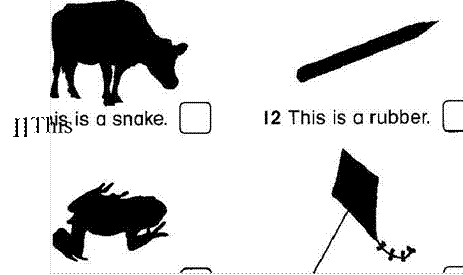
13 This is a shoe. a 14
This 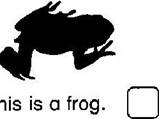 15 This is a kite.
15 This is a kite.

16 This is a bus. a 17 This is a piano. a 18 This is an apple.
![]()
4 1
 Mirror writing
Mirror writingLanguage aim
introduction/practice of common expressions
![]()
![]()
![]()
![]()
![]()
![]() Goodbye!
Happy birthday! Hello! Here
Goodbye!
Happy birthday! Hello! Here
|
you ore. How do you spell |
I don't know. |
|
|
Sorry-
Thanks. |
I Write some words on the board in
mirror writing. Here are some examples to copy. ![]() o]J9JN
o]J9JN ![]()
Ask the class to cetl you what the words are (coc hello, yes).
2 Give out copies of the puzzle. Pupils
should first link the speech bubbles with the speakers, ![]() as this wilt help in
understanding the mirror writing. They then re-write the expressions. Nobody is
allowed to read the speech bubbles using a mirror until the puzzle has been
as this wilt help in
understanding the mirror writing. They then re-write the expressions. Nobody is
allowed to read the speech bubbles using a mirror until the puzzle has been
![]()
I Mirrors![]()
Bring a mirror (or several mirrors) to che lesson. Write three or four sentences on the board. The class must write them in mirror writing.VVhen they have finished, they can use the mirror to check their results.
2 Read the words
Divide the class into two teams. If you feel able to produce
your own mirror writing, use it to write ![]() a word or phrase which
the class has learnt recently on the board. The first team to read it correctly
gets a point. Continue with further
a word or phrase which
the class has learnt recently on the board. The first team to read it correctly
gets a point. Continue with further ![]() words/phrases.
words/phrases.
3 Mirror messages![]()
Each pupil writes a message for his/her neighbour in mirror writing. They then decipher the messages that have been written for them.
completed.
 Crossword
Crossword
![]()
revision activity
Structures
ondjor, some, there is, a/an/the, do/does, have got
Tell the class that they are going to do a revision puzzle, and give out copies.
2 Pupils work individually to
complete the ![]() sentences and then the crossword puzzle.
sentences and then the crossword puzzle.
![]()
Ask the class to make their own crosswords with clues, using the puzzle as a
model. The puzzles should be on separate pieces of paper. Set a minimum of five
words per puzzle, When the puzzles are finished, collect them in and redistribute
them so that everybody has somebody else's puzzle. Pupils then complete the
puzzles they have been given.
Key
|
Across: 2 an |
Down: |
|
3 doesn't 6 hasn't 10 some |
2 and S there |
B do
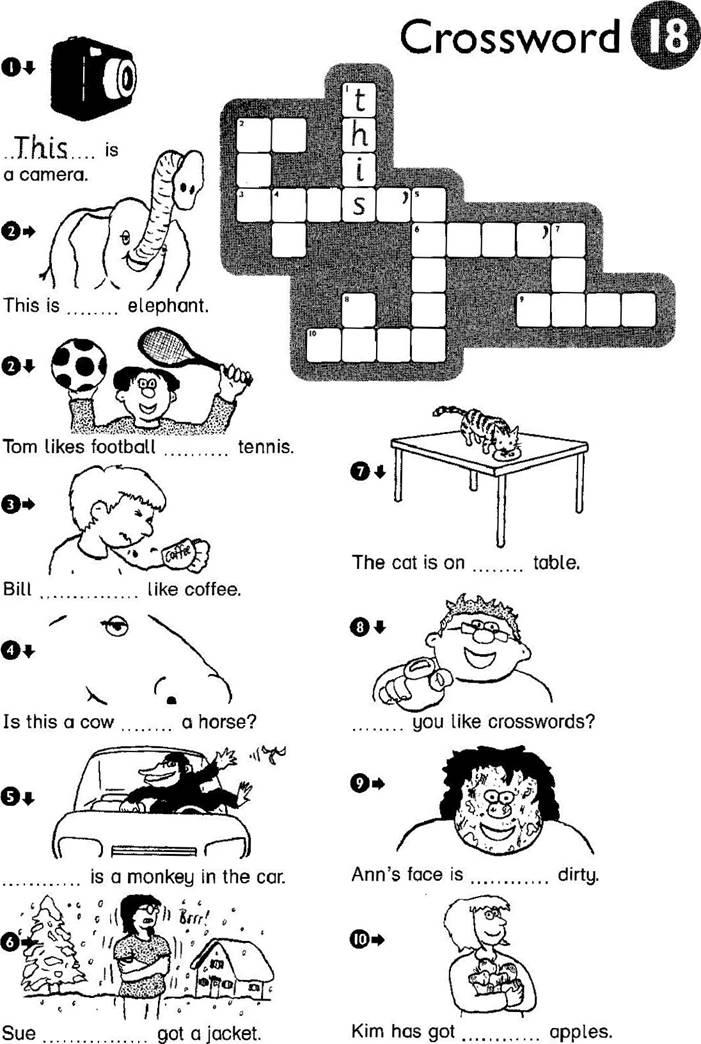
O 2003
 Find the word
Find the wordLanguage aims
• vocabulary revision/extension e practice for a Starters format
Vocabulary
![]()
![]() chair, clock, car, tree, radio, house, flower, train, camera, behind,
under, lorry, cupboard, cross, tick, mirror, motorbike, bookcase, phone,
monster
chair, clock, car, tree, radio, house, flower, train, camera, behind,
under, lorry, cupboard, cross, tick, mirror, motorbike, bookcase, phone,
monster
Procedure
Hand out copies of the puzzle. Check that everybody understands what they are supposed to be doing: identifying the objects.
finding the letters and writing the words. Tell the class to do the ones they can, and to leave any they can't do.
2 Get the class to say the answers out loud and write them on the board.
Alternative method
Divide the class into teams of up to 4, and hand out copies of the puzzle. The team which correctly salves the most clues is the winner (you could give a time limit for this).
|
|
|
|
2 clock |
12 lorry |
|
3 car |
13 cupboard |
|
4 tree |
14 cross |
|
5 radio |
15 tick |
|
6 house |
16 mirror |
|
7 flower |
17 motorbike |
18 bookcase
19 phone
20 monster
![]()
Additional activities
![]() Anagrams
Anagrams
Organise the class into two or more teams. Choose a word from your coursebook, and write an anagram of it on the board. The first team to solve it wins a point. Continue with further anagrams. The team which gets the most points wins.
2 How many words can you make?
Organise che class into pairs/small groups. Write the following letters jumbled-up on the board: a cd e h n o p r s t. The pairs/groups have two minutes to make as many words as they can from these letters (they can use letters more than once if they wish). The pair/team which makes the most wards wins.
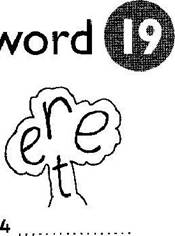


![]()


e
 What are they
What are they Language aim
present continuous verbs
eating, drawing reading, sleeping, talking, opening, painting, writing, jumping, sittjng, Pointjng, singing, cleaning, phoning, asking, listening, watching, closing, having,
 Hand out copies of the
puzzle. Hold up a copy, and point to each monkey in turn. What is he (or she)
doing? For each picture, elicit the word from the key below. Write in random
order on the board any words which seem to be new to some or all of the class,
and check
Hand out copies of the
puzzle. Hold up a copy, and point to each monkey in turn. What is he (or she)
doing? For each picture, elicit the word from the key below. Write in random
order on the board any words which seem to be new to some or all of the class,
and check ![]() pronunciation. Leave them on the board.
pronunciation. Leave them on the board.
2 Pupils
then complete the puzzle. Go round helping if necessary, and point out any
spelling ![]() errors.
errors.
3 Finally, students write the mystery sentence in the space provided. (We are learning English.)
|
Key |
I i sitting |
|
2 eating |
12 pointing |
|
3 drawing |
13 singing |
|
4 reading |
14 cleaning |
|
5 sleeping |
15 phoning |
|
6 talking |
16 asking |
|
7 opening |
17 listening |
|
8 painting |
18 watching |
|
9 writing |
19 closing |
|
|
20 having |
doing?
![]()
I Miming game
Organise the class into two or more teams. Mime ![]() a verb from
your coursebook.Ask, What am } doing? The first team to guess what you are
doing wins a point, Continue with further verbs. Once the game is established,
get pupils to do the miming (whisper or write on a piece of paper the verbs you
want them to mime).
a verb from
your coursebook.Ask, What am } doing? The first team to guess what you are
doing wins a point, Continue with further verbs. Once the game is established,
get pupils to do the miming (whisper or write on a piece of paper the verbs you
want them to mime).
2 Silly pictures
Copy or photocopy this grid, and cut up the cards (alternatively, just point to the required sentence). in turns, pupils come to the board, receive a card, and draw a picture ta illustrate the sentence. The rest of the class try to guess what the sentence is.
|
He is eating a book. |
|
She is sitting on o giraffe. |
|
The dog is having a bath. |
|
The elephant is swimming. |
|
She is walking in the sea. |
|
The cat is eating a banana |
|
The bird is watching tetevision. |
|
He is sleeping in a tree. |
|
The crocodiles are playing football. |
|
The fish is flying. |
|
The elephants are jumping. |
|
The teacher is sleeping in the classroom. |
|
|
|
|
|
20 |
||
|
|
|
|
![]() What are they doing?
What are they doing?

|
|
|
• household objects
• armchair, bed, bookcase, box, chair, clock, cupboard, door, lamp, mag mirror, radio, sofa, table,

I Tell the class you have a list of 15 things you can find in a house. Working in pairs, pupils write down things they think may be on your list. Write your list (the words listed above) on the board, explaining any unfamiliar words and checking pronunciation. Pairs get one point for each icem which matches your list and theirs. The pair with the most points wins.
2 Give out copies of the puzzle. Check that everybody understands what they should be doing: they circle or draw a line through the words they find in the wordsearch.

I Make your own puzzle
Ideally, everybody needs a piece of squared paper. Get pupils to reorganise the vocabulary from the puzzle into a new wordsearch. These new puzzles can then be swapped and solved by another pupil. (Alternatively, tell the class to use a different vocabulary group such as food and drink, or colours.)
2 What is it?
Organise the class into two or more teams.
Choose one of the illustrations from the puzzle. Copy one line onto the board, then another, then another, slowly building up the picture. The first team to correctly identify the picture wins a point. Proceed with further pictures. (If you lack artistic skills, it will be an advantage, as it will make the game more challenging!)
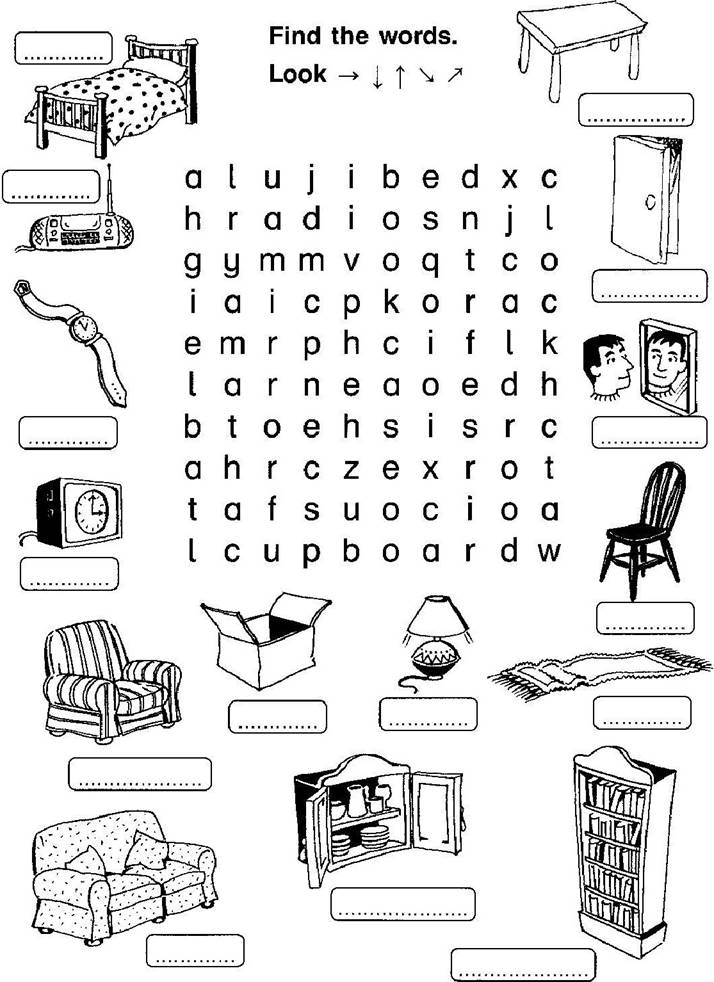
O 5 1
|
|
|
• food and drink vocabulary
Vocabulary
apple, banana, beans, bread, burger, cake, carrot, chicken, coconut, drink, egg, fish, French fries, icecream, lemon, mongo, milk, onion, orange, pear, Pineapple, potato, rice, sausage, tomato, watermelon
Additional activity
Nice or nasty?
Introduce the words nice and nasty. Give combinations such as: sausage and bread, carrot and ice-cream, fish and watermelon, coconut and Pineapple. The class has to shout out if they think the combination would be nice or nasty. If there is a disagreement, take a vote. Then get pairs to chink up and write down five really nasty combinations.
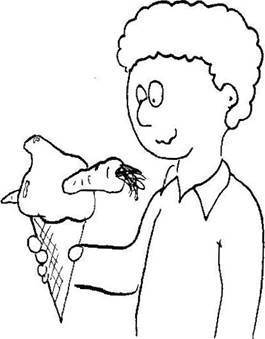

a random order. Next to each, draw a very simple illustration (perhaps copy from the puzzle). Practise the pronunciation of the words.
2 Mime to the class eating/drinking one of the items. The class shouts out the word. Repeat until all the words are being shouted out confidently.
3 Give out the puzzle. Pupils complete it individually, by reading the instructions and joining up the pictures (preferably in pencil). They then complete the sentence at the bottom.
Key
It's a burger and a drink.
pineapple  pear
pear ![]() carrot
carrot
|
orange juice |
|
|
|
orange |
lemon |
|
|
potato |
coconut |
|
|
banana |
milk |
|
|
|
cake |
|
|
chicken—-———— burger |
mango |
|
|
ice-cream-—-—.- bread |
onion—————- French fries |
|
|
bread |
French fries |
|
|
peas |
|
rice |
![]() rice
rice ![]() sausage sausage
sausage sausage ![]() drink watermelon
drink watermelon![]() orange juice milk lemon
orange juice milk lemon
tomato————— pear

 What are they
What are they Language aim
e grammar revision
![]()
Procedure
I Give out copies of the puzzle. The task is to find and circle sentences, and then put them into the correct speech bubbles (with spaces
between the words). Ask the class to complete the puzzle in pencil, so mistakes can be corrected.
2 Go through the answers with the class.
Key![]()
2 Whose is this?
3 Is it a television?
4 What are these?
5 What are you doing?
6
This is my ice-cream.![]()
7
I don't like milk. 8 I like apples.![]()
9 It's a big plane.
10 1've got a kite.![]()
![]()
saying?
![]()
Additional activities
![]() Act the sentence
Act the sentence
![]() Organise the class into groups of 3 or 4.
Each group has to act out all the illustrations in the puzzle. Make it clear
that pupils must take it in turns to do the speaking. (Younger classes may lack
the cooperation skills required for this
Organise the class into groups of 3 or 4.
Each group has to act out all the illustrations in the puzzle. Make it clear
that pupils must take it in turns to do the speaking. (Younger classes may lack
the cooperation skills required for this ![]() activity.)
activity.)
2 More phrases
![]() On the board, write some more phrases from your
coursebook. Pupils must illustrate the
On the board, write some more phrases from your
coursebook. Pupils must illustrate the ![]() phrases with drawings and speech bubbles,
as in
phrases with drawings and speech bubbles,
as in ![]() the puzzle. (Choose sentences which can be
illustrated with the most basic of artistic skills.)
the puzzle. (Choose sentences which can be
illustrated with the most basic of artistic skills.) ![]()
![]() Display the work on
the classroom walls.
Display the work on
the classroom walls.

 Listen to the
Listen to the |
|
|
pronunciation practice
wear, no, say, face, two, red, throws, ear, hair, or, they, right you, me, my, here, clean, door, these, write, nose, know, eye, bookcose, green, head, trees, sea
I Everybody will need a ruler and a pencil.
2 Check that everybody understands the concept of rhyming words - practise rhyming phrases such as fot cot, there's a mouse in the house, red bread, sheep go to sleep, look at my book.
3 Give out copies of the puzzle, but teli the class not to do anything yet.
4 Go round the puzzle getting the class to practise saying the words. Clarify any meanings.
5 Using a ruler, pupils connect the words which rhyme with each other. Doing this wili produce a geometric pattern which early finishers may like to colour in.
ear
throws
red
![]()
Organise the class into teams of 2 to 4. Choose a word from the list below, and say it. Each team then has a minute to think of as many words which rhyme with it as possible-Ac the end of the minute, the team which has written the most words wins a point. Continue with further words from the list, bed, tree, radio, chair, those, cot, peas, draw
me
![]() you mg
you mg
wear trees
sea
me
you mg
here clean
• door
![]() earwrite
earwrite
throwsnose
red e know
![]()
![]() eye
eye
no head wear trees
sea
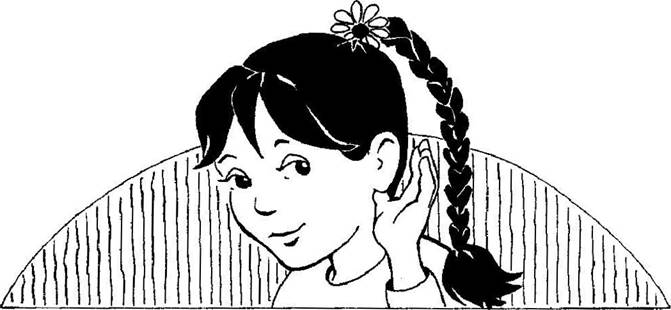
(9 57
 What's the word?
What's the word?
|
Language aim |
![]() Additional
activity
Additional
activity
![]() vocabulary revision Word
clues
vocabulary revision Word
clues
|
Vocabulary |
Organise the class into two or more teams. Choose a word
(e.g. elephant) and on the board write a line for each letter ( _![]()
![]() See key below and
puzzle Then give clues one at a time (IL's an onimal, It's very big, It's
gæy).The first team to guess correctly wins a point. Repeat as required.
See key below and
puzzle Then give clues one at a time (IL's an onimal, It's very big, It's
gæy).The first team to guess correctly wins a point. Repeat as required.
I Write the answers (see key below) jumbled up on the board. (If you want to make it rnore challenging, add some extra words.)
2 Give out copies for the class to complete. Check that everybody knows what they should be doing: finding words from the written clues.
3 Answer vocabulary queries as they arise.
Organise the class into two or more teams. As an example, read out the clues for number i and give the answer. Repeat with 2. Then read out the clues for number 3. The first team to guess the 'mystery' word wins a point. Continue through the rest of the puzzle. Afterwards, hand out copies of the puzzle for completion by the class.
|
2 football |
12 ball |
|
3 book |
13 piano |
|
4 television |
14 dining room |
|
5 monkey |
15 crocodile |
|
6 jeans |
16 flower |
|
7 birthday |
17 socks |
|
8 watermelon |
18 cow |
|
9 bedroom |
1 9 bathroom |
|
10 numbers |
20 names |
|
I i snake |
21 question |
What's word?
![]() teacher I lesson / board schoo l
teacher I lesson / board schoo l![]()
2 sport /
play kick ![]()
4 watch / picture ![]()
5 banana I ooh ooh ooh! ![]()
6 wear I trousers I blue ![]()
7 favourite day / How old are gou
today?![]()
8 fruit / green I verg big ![]() 9 room I sleep
9 room I sleep ![]()
![]()
Il long no legs I ssssssssss!
![]()
![]()
![]()
14 room / eat I table
![]()
15
animal I green I
water I teeth ![]() 16 garden 1 beautiful / colours
16 garden 1 beautiful / colours ![]() 17 wear / teet I shoes and .
17 wear / teet I shoes and .![]()
19
room / have a bath ![]()
 I Kim I Pat / Sue / Sam
I Kim I Pat / Sue / Sam
|
|
|
• vocabulary revision/extension
• bed, bath, bread, book, ball, bag, bike/bicycle, burger, box, boy, baby, beach, boat, board, bird, bookcase
I Hand out copies of the puzzle, but teli the class not to do anything yet.
2 Ask the class co put up their hands and point to something in the picture which begins with
b. Continue until about 8 items have been named.
3 Pupils write these words into the spaces at the bottom of the puzzle, and then look for more words.
Organise the class into groups of 2 to 4. Each group boks for words beginning with b, and writes them in the spaces below the picture. The group which finds the most (in a given time) or the first group to find 16 wins.
baby, bag, ball, bath, beach, bed, bike/bicycle, bird, board, boat, book, bookcase, box, boy, bread, burger (total 16)
Additional activity
Organise the class into two teams. Choose a letter from the list below, and say it. The first member of Team A must think of another word which begins with that letter. Then it is the turn of the first member of Team B, then the second member of team A and so on. When somebody can't think of another word, the opposite team gets a point. Continue the game with further letters.
Suitable letters: a, c, d, f, g h, m, p, s, t
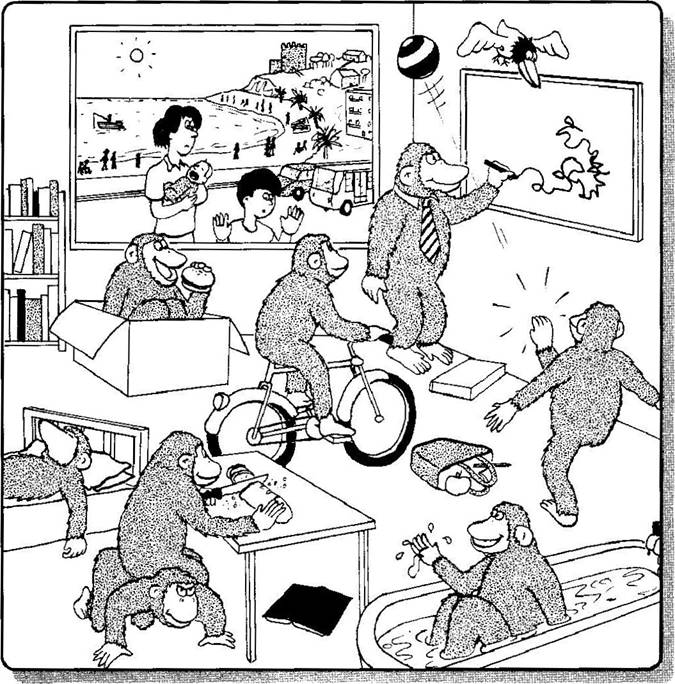
Find words which begin with b

![]() PUBLISHING 2003
PUBLISHING 2003
 On the phone
On the phone![]()
|
|
Pick a pupil and say one of che phrases from the |
|
|
left-hand column of the puzzle. The pupil must |
|
expressions |
answer with a different phrase to the one in the |
puzzle. Continue with other phrases and pupils.
Hand out copies of the puzzle, but tell the class not to do anything yet.
2 Make the noise of a telephone ringing. Point to a pupil - she or he must pick up an imaginary phone to answer your call.
3 Say the first phrase from the left column (What's your nome?). The chosen pupil has to answer (My name's Bill).
4
Choose another pupil and continue with the next phrase (Have you
got o ![]() time the pupil will have to find the
answer on the worksheet (Yes, hove or $ don't know are both acceptable).
time the pupil will have to find the
answer on the worksheet (Yes, hove or $ don't know are both acceptable).
5 Continue through the phrases with other
6 The class completes the puzzle in pencil. Although don't know can initially be matched with several of the left-hand phrases, to complete che puzzle correctly, it can only go with How do you spell comPuter?
Key
Have you got o pen? Yes I hoveI like cots. So do l.
Happy birthday! It's not my birthday.
Can you ride a bike? No, I can't.
Are you a boy? No, I'm not.
How do you spell computer? f don't know.
What co[our ore your socks? They're blue How many children are there in your class? Ten.
Whot are you doing? I'm talking to you.

 ; What am l?
; What am l?
Language aim
vocabulary revision/extension practice for a Starters format
house, sun, bed, milk, bike, bread, Picture, chair, hat,
hair, book, sea, pea, tennis, water
I Give out copies of the puzzle.
2
![]()
3 Get the class to continue independently.
Answer any vocabulary queries as they arise. (To make the puzzle easier, write the answers on the board in a random order.)
![]()
![]()
![]() Working individually or in pairs, the class has five minutes to come
up with more 'What am l?' clues, Get the class to challenge you with their
riddles (they must also give you the number of letters in the word). For each
that you can guess, you gain a point; for each that you can't guess, the class
gains a point.
Working individually or in pairs, the class has five minutes to come
up with more 'What am l?' clues, Get the class to challenge you with their
riddles (they must also give you the number of letters in the word). For each
that you can guess, you gain a point; for each that you can't guess, the class
gains a point.
Organise the class into teams of three to four. Each team
devises at least three more riddles as in the puzzle. Team A then asks team B
to solve one of their riddles (they must also give the number of letters in the
word). If Team B can't answer, Team C has a chance and so on. The first team to
guess the riddle gets a point. If nobody can guess the riddle, it must have
been too difficult, and Team A loses one point. Then it is Team B's turn to
ask, and so on.![]()
2 house 9 chair
![]() 10 hat
10 hat
12 sea
|
6 bike |
|
|
7 bread |
14 tennis |
|
8 picture |
15 water |
What am l ?
|
2 |
You can live in me. I've got rooms. |
|
|
3 |
You can't see me at night. |
|
|
4 |
You can sleep on me. |
I'm a |
|
5 |
You can drink me. I'm white. |
I'm |
|
6 |
You con ride me. |
|
|
7 |
You can eat me. I'm white or brown. |
I'm |
|
8 |
You can draw or paint me. |
I'm a |
|
9 You can sit on me. |
I'm a |
|
10 You can wear me on gour head. |
I'm a |
|
|
I'm |
![]()
12 Fish live in me. ![]()
13 You can eat me. I'm green and verg
small.![]()
15 You drink me. I haven't got a colour. I'm
![]()
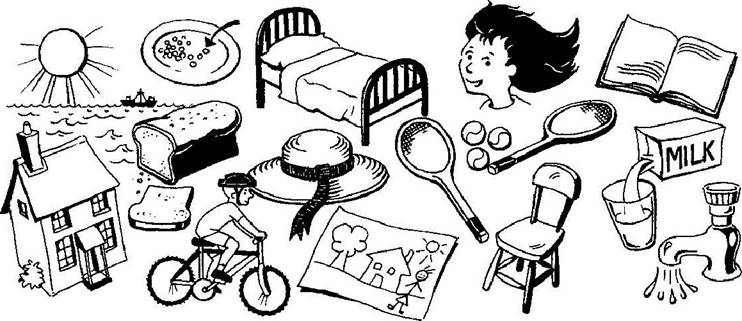
 Listening puzzle
Listening puzzleLanguage aims
• prepositions of place
• colours
• listening practice
• practice for a Starters format
• between, behind, in front of, next to, on, under, lorry, clock, giraffe, cat, robot, jeans, doll, car, monster, snake, bird, spider, apple, red, orange, yellow, brown, Pink, red, grey, green, purple, blue

1 Each pupil needs colouring pens/pencils. 2 Give out copies of the puzzle.
3
Check the vocabulary by holding up a copy ![]() (or projecting it
using an OHP), pointing to something in the picture and asking, What is it? or,
HOW many snakes are there? Repeat this until everybody seems confident with the
vocabulary.
(or projecting it
using an OHP), pointing to something in the picture and asking, What is it? or,
HOW many snakes are there? Repeat this until everybody seems confident with the
vocabulary.
4 Ask questions using the prepositions of place: What's on the radio? What's between a pair of jeans and a cot?
5 Read the following instructions.
Find a lorry next to a clock. Colour the lorry blue.
Find a giraffe in front of a cat Colour the giraffe yellow.
Find a pair ofjeans between a cot and a robot. Colour the jeans blue.
Find o car under a doll.
Colour the cor purple.
Find a snake behind a monsterColour the snake green.
Find a robot in front of a snake. Colour the robot grey.
Find a bird in front of a monster and a snake. Colour the bird Pink.
Find a monster under a spider. Colour the monster red.
Find a doll on a car.
Colour the doll Pink.
Find o cat behind a giraffe.
Colour the cat brown.
Find a snake behind a bird. Colour the snake yellow. Find a snake behind o robot Colour the snake orange.
Find an apple between o doll and a robot Colour the apple red.
What word con you see?
Key
Hello
![]()
I Simon says
Use the prepositions of place from che puzzle for a round or two of this game. (For the rules, see General Activities section.) Give instructions such as (Simon says) put your pen under your book and (Simon says) stand next to your chair.
2 Picture dictation
Give the following instructions;
Draw o small house.
Draw a tree.
Between the house and the tree, drow a man.
Behind the house, drow another tree.
In front of the house, drow a bicycle ![]() Next to the house, draw a chair. On the
chair, drow a girl.
Next to the house, draw a chair. On the
chair, drow a girl.
Under the chair, draw a spider.
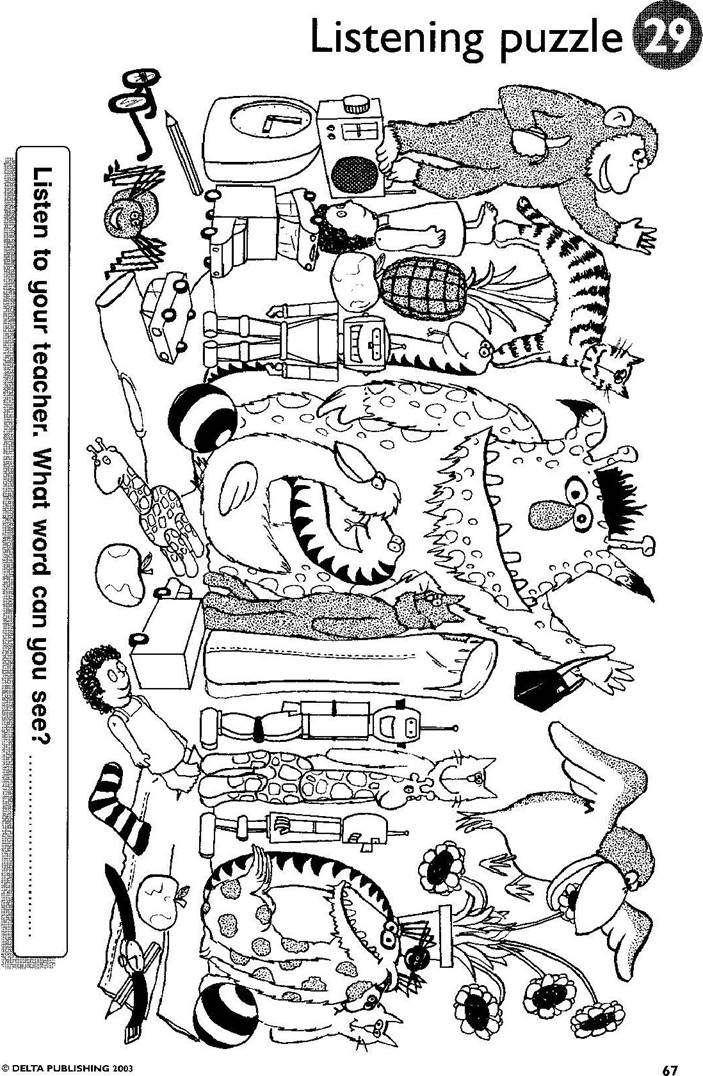

![]()
![]() vocabulary practice Divide
the class into two teams. Team A suggests a word which you write horizontally
on the board. Then team B says a word which starts
vocabulary practice Divide
the class into two teams. Team A suggests a word which you write horizontally
on the board. Then team B says a word which starts ![]() vertically down from
the last letter of team A's word-The object is to suggest words which are as
vertically down from
the last letter of team A's word-The object is to suggest words which are as
Hand out copies of the puzzle. long as possible.\Nhen each team has given five the board, write one way of completing words, count up the letters. The team which has total'ed the most letters wins a point. Repeat as required.
![]()
![]()
![]()
![]() a
a
3 Pupils complete their puzzles using different words to your example.

![]()
PUBLISHING 2003
Mini-puzzles teacher's notes
a or an
![]() articles: olon
articles: olon
I Give out copies of the puzzle, but tell the class not to write anything yet.
2 Go through the puzzle with the class saying each item: a cat, on apple, an elephant, etc. Pupils then complete the puzzle.
Key an elephant, ear, arm, eye, egg a banana, hand, hat, shoe, leg
 Whose is it?
Whose is it?
Language aim
• possessive 's
![]() I Hand out copies of
the puzzle, but tell the class not to write anything yet.
I Hand out copies of
the puzzle, but tell the class not to write anything yet.
2 Check the names of the animals in the illustration at the top of the puzzle- Go through the puzzle eliciting the owner of each
3 The class then completes the puzzle in writing.
4 Go through the answers. Ask the class if anyone has noticed the difference between the pronunciation of horse's/mouse's and the other 's words in the puzzle.
2 horse's 3 elephant's 4 mouse's
![]() 5
crocodile's 6 tiger's 7 cat's 8 bird's
5
crocodile's 6 tiger's 7 cat's 8 bird's
70
this, that, these, those
![]() this/that/these/those
this/that/these/those
![]() Practise the target
vocabulary using classroom examples (What's this? What are those?).
Practise the target
vocabulary using classroom examples (What's this? What are those?).
2 Hand out copies of
the puzzle. Pupils ![]() complete it by putting this, that, these
or those into the gaps in the speech bubbles, and then writing those same words
into the relevant boxes in the word puzzle.
complete it by putting this, that, these
or those into the gaps in the speech bubbles, and then writing those same words
into the relevant boxes in the word puzzle.
3 The vertical shaded
coiumn will then read he i o_te_. Ask the class if anyone can guess the word
(helicopter). Finally, practise the ![]() sentences for pronunciation.
sentences for pronunciation.
|
I that |
1 these |
3 this |
|
4 those |
5 that |
6 these |

![]() interrogatives: which, what, who,
whose, where
interrogatives: which, what, who,
whose, where
![]() Practise the target
language using classroom
Practise the target
language using classroom ![]() examples (Where's my book, Which is your
pen?).
examples (Where's my book, Which is your
pen?).
2 Hand out copies of the puzzle. Pupils complete it by filling the gaps in the speech bubbles with a wh word. They then write these in the crossword grid.
3 Go through the answers, and practise the
sentences for pronunciation.![]()
Across: 3 whose 5 which 6 what Down: I who 2 where 3 which 4 what
thanks v this
![]() pronunciation of th
pronunciation of th
![]() Hand out copies of the
puzzle, but tell the class not to write anything yet.
Hand out copies of the
puzzle, but tell the class not to write anything yet.
2 Practise the words at the bottom of che puzzle (including thanks and this). Make sure everyone understands that there are two distinct th sounds. Continue until everybody is confident with both pronunciations of th.
3 Say one of the words
again, The class shouts out thanks or this depending on which column ![]() the
word should go into. Continue with the other words, then the class completes
the puzzle.
the
word should go into. Continue with the other words, then the class completes
the puzzle.
4 Go through the answers.Ask the class if anyone can think of any more words with th. Which column should these new words go into?
thanks: mouth, birthday, three, throw, bath this: the, there, they, mother, clothes, with
1.2
O Where's the bird?
![]() prepositions af place: in. on,
under, next to, between, behind, in front of
prepositions af place: in. on,
under, next to, between, behind, in front of
![]() I Practise the
prepositions using examples in
I Practise the
prepositions using examples in ![]() the classroom.
the classroom.
2
![]() Hand out copies of the puzzle. The object is to
Hand out copies of the puzzle. The object is to ![]() solve
the anagrams, and then find the words in the wordsearch.
solve
the anagrams, and then find the words in the wordsearch.
3
Go through the answers. Ask the class to ![]() write one sentence
about the classroom with each of the prepositions.
write one sentence
about the classroom with each of the prepositions.

The word is ...![]()
Language aim ![]() adverbs
adverbs
I This puzzle is intended for classes
which are already familiar with most of the vocabulary.![]()
2 Hand
out copies of the puzzle. The object is to put the words at the top of the page
into the gaps in the speech bubbles, and then write these words in the
crossword.![]()
3 Go through the answers, and practice the sentences for pronunciation.
Down: today 3 here 6 not

71
 9SOLlM
9SOLlM
![]()
![]()
![]() 'asatll 0をお一
'asatll 0をお一
![]() 4 1 7
4 1 7


76


![]()
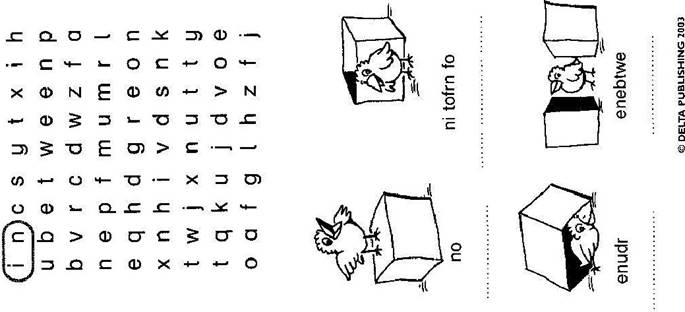

Grammar index Topic index
|
adjectives 5, 7 |
alphabet |
|
|
adverbs 37 |
adjectives 5, 7, i O, 25 |
|
|
|
adverbs 37 |
|
|
be 3 |
animals 6, 7, 10, 16, 29, 32 |
|
|
can/can't 9, 1 0, 27, 28 |
body parts I l, 31 |
|
|
do/does 1 0, 1 8 |
classroom vocabulary 14, 15 |
|
|
have got 7, 10, 1 8, 23, |
|
|
|
imperatives 1 4 |
|
|
|
or 1 8 |
family members 8 |
|
|
plural s |
food and drink 9, 22 |
|
|
possessive s 8, 31 |
furniture 1 9, 21 |
|
|
prepositions of place 29, 36 |
|
26, 27 |
![]()
![]() (Numbers refer to the puzzle, not the page)
(Numbers refer to the puzzle, not the page)
![]()
![]() present continuous 13, 15, 20
present continuous 13, 15, 20![]() household obiects 21 question forms
'O, 18, 23, 27, 34
household obiects 21 question forms
'O, 18, 23, 27, 34![]() names 3, 5, 8, 9
names 3, 5, 8, 9 ![]() simple present 3, 5, 10, 1 8 numbers 6
simple present 3, 5, 10, 1 8 numbers 6
some 1 8 prepositions 19, 29, 36
there is[there are 6, 1 5, 1 8 questions and expressions 17, 27
these 23, 33 ![]() this 16, 23, 33
this 16, 23, 33![]()
whose 23
transport 19 verbs 10, 15, 20, 25
79
Материалы на данной страницы взяты из открытых источников либо размещены пользователем в соответствии с договором-офертой сайта. Вы можете сообщить о нарушении.